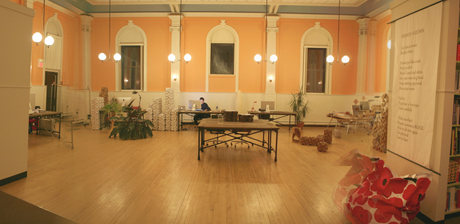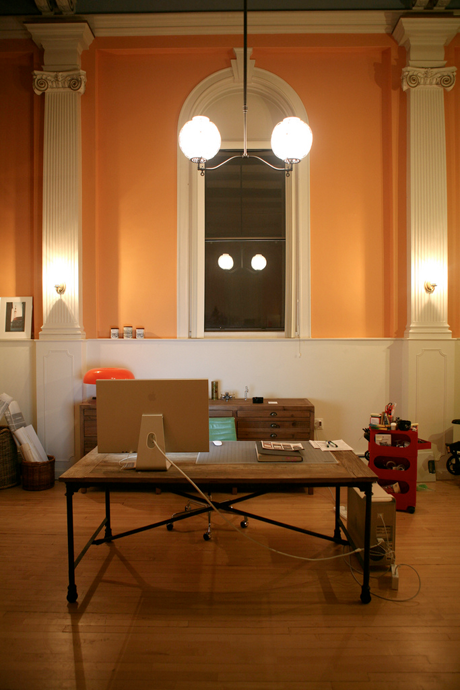The space in which we work defines us, both as individuals and as teams. Sometimes we're unaware of how important our office environment is, but the fact remains that it's key to our every day mental health and our ability to perform. Our work space effects whether we're able to get our work done and whether we enjoy doing it. Of course, the digital life of the knowledge worker provides a measure of flexibility when choosing working environments. With the need only for a laptop and a broadband connection, we can easily work remotely at home or in shared co-working spaces, in coffee shops or even in public areas. The question comes down to: How do we work best, especially with others on our team? For businesses: How do we optimize our physical space so that it serves both the well being of the team members, as well as productivity? At Involution Studios Boston, we have settled on an open floor plan, with desks more or less clustered according to work function type.

The Involution studio, located in historic Arlington, Massachusetts, used to be a ballroom
Beauty and Work Balance
At Invo, we're lucky to have space in an unique building in historic Arlington, Massachusetts; There is something wonderfully satisfying about working in a refurbished turn of the century ballroom. The tall windows allow in lots of light and the balcony serves as a reminder of the times when the hardwood floors were used for dancing. Since we are a design company, and largely comprised of visual people, this beautiful atmosphere matters in a significant way. Having worked at various Internet start ups, in a variety of downright ugly environments, I can say that our studio is among the most attractive office spaces I've had the privilege to work in. I've worked in a cubical, in my own private office, and now in an open floor plan. Of all of these, I can say that the cube farm was the least desirable from my perspective as a designer: Aesthetically, I found the dull sameness of that type of workspace to be oppressive. In contrast, the open ballroom fills me with joy when I enter it each morning.
Collaboration vs. Concentration: A New Work Culture
The debate over open space versus offices has raged for a long time. In many instances, I've seen the open floor plan executed where managers are separated from the staff in offices that ring a central open area filled with cubicles or desks. At Invo, all of the staff, including the Creative Director, sit in the same area. We do have an open discussions and sometimes shout across the studio. There's no doubt that the open floorplan requires a degree of communication discipline from everyone.
Since we're a boutique shop, and productivity is critical to finishing projects on time and on budget, we've developed a studio culture that respects the work ethic. To solve the problem of distraction that inevitably comes from having an open floor plan, we've cultivated signals and protocols for optimizing work productivity in open space. Wearing headphones, of course, means that you don't want to be bothered. We communicate via e-mail and IM for less pressing matters or to avoid shouting: While it can be a little weird to IM a person sitting next to you, we do it anyway. Additionally, we've instituted quiet time, when nobody is allowed to talk in the main studio room. As we've grown as a shop, we've also acquired conference room space, elsewhere on the third floor, which gives us a quiet room to meet with clients or a place to go if you really need isolation in order to concentrate. Lastly, there also seems to be a natural ebb and floor to conversation around projects. More discussion happens first thing in the morning when everyone arrives, and less in the afternoon when everyone is heads down working on their projects.

Working late
Distractions are Fun?
Would this type of culture work for a less devoted crew? If you're looking for distractions in an open studio space, they're easy to find, no doubt.
In an article on GigaOm, "Open-Plan Workspaces: Getting Cozy with your Coworkers", Joel Spolsky, head of Fog Creek Software, says:
“Open space is fun but not productive,” noting how a conversation between two people can distract a bunch more, whereas more private workspaces keep distraction from spreading to all people in the space.
In our case at Invo, yes, we like to have fun at our studio, and the open floor plan facilitates that. However, in the studio, we also have found great ways to be both productive and collaborative, working within the constraints that come with the open floor plan. On the collaboration side, we've almost eliminated the need for formal team meetings: Discussions to solve problems are immediate and quick. And brainstorming on walls, painted with IdeaPaint, are seen by all. Overall, the team collaborative culture is strong with us at Invo, and I think it improves our ability to deliver great software designs.
The occasional times when I work at my home office, I definitely feel like I miss the studio, the conversation, collaboration, and camaraderie. And maybe that's the secret to open space. Whatever the case, I enjoy coming into work every day. And, I suppose, that's the real bonus.